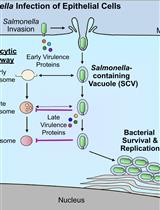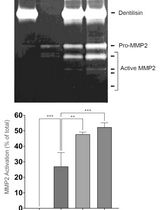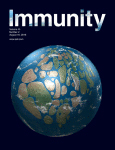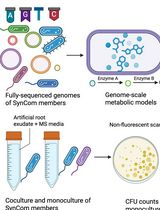- EN - English
- CN - 中文
Isolation and Infection of Drosophila Primary Hemocytes
果蝇原代血细胞的分离和感染
发布: 2017年06月05日第7卷第11期 DOI: 10.21769/BioProtoc.2300 浏览次数: 10849
评审: Ruth A. FranklinBenoit ChassaingRamalingam Bethunaickan

相关实验方案

细菌病原体介导的宿主向溶酶体运输的抑制:基于荧光显微镜的DQ-Red BSA分析
Mădălina Mocăniță [...] Vanessa M. D'Costa
2024年03月05日 2443 阅读

通过制备连续聚丙烯酰胺凝胶电泳和凝胶酶谱分析法纯化来自梭状龋齿螺旋体的天然Dentilisin复合物及其功能分析
Pachiyappan Kamarajan [...] Yvonne L. Kapila
2024年04月05日 1655 阅读
Abstract
Phagocytosis of invading pathogens and their subsequent clearance in lysosomes is important for organismal fitness. We have devised the following protocol to extract phagocytic hemocytes from wild-type and mutant Drosophila larvae and infect the isolated hemocytes with GFP-labeled E. coli to measure the rate of phagocytosis and degradation within individual hemocytes over time.
Keywords: Drosophila (果蝇)Background
The experiment described below can be used to study phagosome biogenesis, maturation, and delivery to lysosomes. Bacterial accumulation has been well studied in the context of immuno-compromised Drosophila with defects in IMD or Toll signaling and the resulting reduced expression of antimicrobial peptides (e.g., Lemaitre and Hoffmann, 2007; Kleino and Silverman, 2014). Cellular responses to bacterial infections have been less investigated in Drosophila, with most studies focused on mutations that interfere with the initial phagocytic uptake of bacteria by hemocytes (Kocks et al., 2005; Parsons and Foley, 2016). Such bacterial uptake is straightforward to measure using FACS analysis (Tirouvanziam et al., 2004). For a detailed analysis of phagosomal maturation, however, we found it advantageous to examine individual hemocytes attached to a glass cover slip (Akbar et al., 2011; Rahman et al., 2012; Akbar et al., 2016) as this procedure offered us the best combination of temporal and spatial resolution for our studies of phagosome maturation.
Materials and Reagents
- Falcon tubes (15 ml) (Corning, Falcon®, catalog number: 352196 )
- Eppendorf tubes
- Cover glass, No 1.5, 22 mm2 (Corning, catalog number: 2850-22 )
- Petri dish (100 x 15 mm) (Corning, catalog number: 351029 )
- Kimwipe
- Micro slides (Corning, catalog number: 2948-75X25 )
- Sterile filter unit: 0.22 µm cellulose acetate filter flasks (Corning, catalog number: 430769 )
- Drosophila melanogaster wandering third instar larvae (Ashburner, 1989)
- E. coli (DH5α) constitutively expressing GFP
- peGFP (https://www.addgene.org/vector-database/2485/)
- pET-GFP-C11 (http://www.addgene.org/30183/)
- peGFP (https://www.addgene.org/vector-database/2485/)
- Bucket of ice
- LB growth media (Fisher Scientific, catalog number: BP1425-500 )
- Schneider’s Drosophila medium (Thermo Fisher Scientific, GibcoTM, catalog number: 21720 ) with 10% FBS (Atlanta Biologicals, Advantage, catalog number: S11095 )
- S2 cell media
- PBSS = 0.3% Saponin (Sigma-Aldrich, catalog number: S7900 ) in PBS
- 10% NGS
- Phalloidin Alexa 594 (Thermo Fisher Scientific, InvitrogenTM, catalog number: A12381 )
- Vectashield (Vector Laboratories, catalog number: H-1000 )
- Clear nail polish
- Sodium chloride (NaCl) (Fisher Scientific, catalog number: S271 )
- Potassium chloride (KCl) (Sigma-Aldrich, catalog number: P9541 )
- Sodium phosphate dibasic heptahydrate (Na2HPO4·7H2O) (Sigma-Aldrich, catalog number: S9390 )
- Potassium phosphate monobasic (KH2PO4) (Fisher Scientific, catalog number: P285 )
- Hydrochloric acid (HCl)
- Sodium hydroxide (NaOH)
- Paraformaldehyde (Electron Microscopy Sciences, catalog number: 19208 )
- 10% normal goat serum (Jackson ImmunoResearch, catalog number: 005-000-121 ) in PBSS
- 10x PBS (see Recipes)
- 8% paraformaldehyde (see Recipes)
- Fixative: 4% paraformaldehyde in PBS (see Recipes)
Equipment
- Spectrophotometer (Molecular Devices, model: SpectraMax M2 )
- Low speed centrifuge for 15 ml Falcon tubes (Eppendorf, model: 5804 R )
- Dissecting stereomicroscope with Leica L2 cold light source (Leica Microsystems, model: Leica L2 )
- Fine dissecting forceps (Fine Scientific Tools)
- 37 °C incubator with shaking (Eppendorf, New BrunswickTM, model: Innova® 44 )
- 25 °C incubator (BioCold Environment, model: BC49-IN )
- Dissecting dish
- Confocal Microscope
Note: We use a Zeiss LSM510 (Zeiss, model: LSM510 ) with 63 x NA1.4 objective.
Software
- ImageJ (NIH)
- Prism (GraphPad)
Procedure
文章信息
版权信息
© 2017 The Authors; exclusive licensee Bio-protocol LLC.
如何引用
Tracy, C. and Krämer, H. (2017). Isolation and Infection of Drosophila Primary Hemocytes. Bio-protocol 7(11): e2300. DOI: 10.21769/BioProtoc.2300.
分类
免疫学 > 动物模型 > 果蝇
微生物学 > 微生物-宿主相互作用 > 细菌
细胞生物学 > 细胞分离和培养 > 细胞分离
您对这篇实验方法有问题吗?
在此处发布您的问题,我们将邀请本文作者来回答。同时,我们会将您的问题发布到Bio-protocol Exchange,以便寻求社区成员的帮助。
提问指南
+ 问题描述
写下详细的问题描述,包括所有有助于他人回答您问题的信息(例如实验过程、条件和相关图像等)。
Share
Bluesky
X
Copy link










